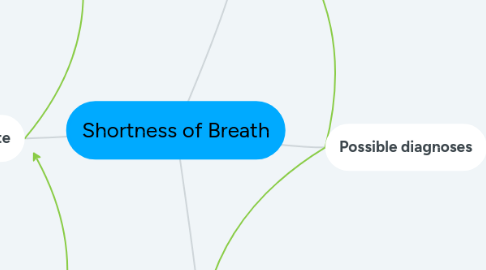
1. Vindicate
1.1. Inflammation/Autoimmune
1.1.1. Pneumonia
1.1.2. Bronchitis
1.1.3. COPD
1.1.4. Asthma
1.1.5. Allergies
1.2. Cardiovascular
1.2.1. Pulmonary embolism
1.2.2. Heart Failure
1.2.3. Pulmonary edema
1.3. Trauma
1.3.1. pneumothorax
1.4. Anxiety
1.5. Lung cancer
2. Negative Key Features: No cough, no shortness of breath at night, no fever or chills
3. Positive key features: history of asthma and COPD, SOB on exertion, BLE edema
4. Possible diagnoses
4.1. COPD
4.1.1. recurrent colds and URIs, progressive dyspnea on exertion, fatigue, morning cough, crackles in lungs. Weakness may be associated. Acute exacerbation may include cough, fever and/or change in amount, texture and color of sputum,
4.1.1.1. Patient has a history of COPD. He denies cough but complains of increased DOE and weakness. Physical exam is positive for crackles. This will number #1 on the list.
4.2. Pulmonary embolism
4.2.1. Shortness of breath, chest pain, hypoxia
4.2.1.1. Patient has Atrial fibrillation and is only taking aspirin so he is at risk for a blood clot. His hypoxia, however, only occurs with exertion. This can be deadly so it must be considered.
4.3. Pneumonia
4.3.1. sudden onset of fever, cough, fatigue, or pleuritic chest pain. productive cough may reveal dark colored sputum. Chills, sweats, and myalagia may occur.
4.3.1.1. Patient denies fever and is afebrile upon presentation to clinical. He is 96 so I must keep in mind that older adults may not present with fever. He is of advanced age and an infection could cause his condition to deteriorate quickly. Chest x-ray today could not rule out pneumonia.
4.4. Lung cancer
4.4.1. Patients can be asymptomatic. Symptoms include sputum production, cough, dyspnea, hemoptysis, pleural effusions, and wheezing. Risk factors include smoking, environmental exposure, and 1st degree relative with diagnosis
4.4.1.1. There are no significant risk factors besides age. However it is always a possibility. No nodules or masses observed on x-ray.
4.5. Pulmonary edema
4.5.1. shortness of breath, wheezing, fatigue, most commonly due to heart failure
4.5.1.1. The chest x-ray does show effusions and ROS is positive for wheezing.Patient does not have a history of heart failure. This is a close diagnosis.
